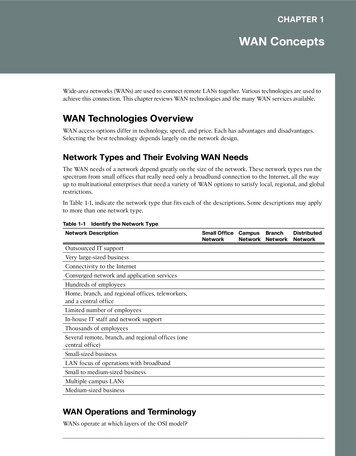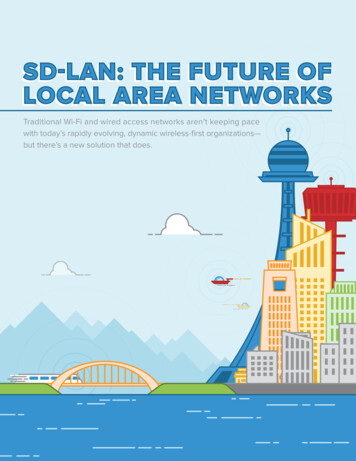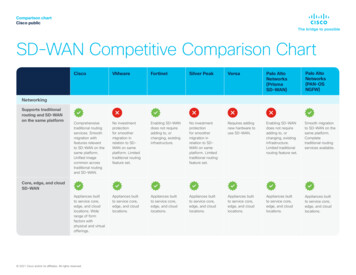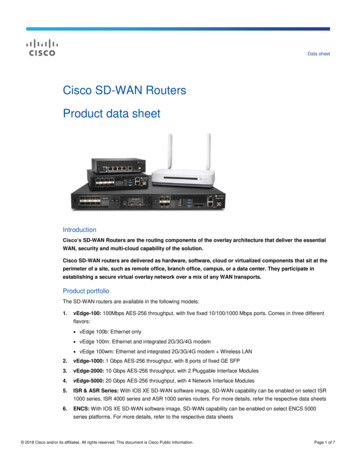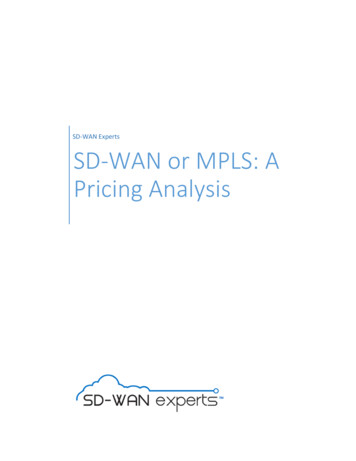
Transcription
SD-WAN ExpertsSD-WAN or MPLS: APricing Analysis
It’s pretty much axiomatic among SD-WAN providers that organizations can save money byswitching to SD-WANs. The low-cost of Internet services relative to MPLS services allowscompanies to reduce their monthly spend on bandwidth “by as much as 90%” as some SD-WANproviders claim.Here at SD-WAN Experts, we’re not tied to any one technology, recommending SD-WANs orMPLS depending on user requirements. SD-WANs often reduce monthly bandwidth charges,but rarely do those savings approach 90 percent. One recent WAN analysis we ran for acustomer, for example, showed a monthly bandwidth savings of only 10 percent. We stillthought SD-WANs were the right call for several reasons. Here’s why.The ScenarioThe customer was interested in reducing his monthly MPLS spend. The company had MPLS to11 locations across the US — 1 data center and 10 branch offices. Each location was within40ms of the data center.The customer spent 15,200 a month on primary recurring charges — 2,200 for a 20 Mbps/sMPLS connection at the data-center, 825 for 5 Mbps MPLS connections at branch offices. Inthe event of an MPLS outage, the locations would VPN over the secondary Internet connectionsto one another. The monthly charge for all secondary Internet connections was 5,650. GeneralInternet access to all the sites was only provided through a centrally firewalled connection atthe data center.SD-WAN AlternativeTo replace MPLS with direct Internet access (DIA) connections, we recommended bringing a100 Mbps connection into the data center and 10 Mbps into the branch offices. The customerwould keep the secondary connections and add LTE connections for additional redundancy.1 Page
SD-WAN would reduce their bandwidth charges, but not by 90%. All totaled monthly savingswould be 24 percent when compared with MPLS (see table 1). The real difference, though, wasin the value of SD-WAN.Table 1: MPLS vs. SD-WAN Pricing ScenarioMPLSBandwidth Primary (MPLS)DataCenterUSA D-WANApplianceDIALTETotal20 2,200.00 1,100100 500 458 25 9835 825.00 25010 175 135 25 3355 825.00 1,20010 500 135 25 6605 825.00 1,20010 1,100 135 25 1,2605 825.00 30010 275 135 25 4355 825.00 35010 1,050 135 25 1,210 10,450.00 5,650Subtotal 6,553DIA Direct Internet AccessAll costs are assumed to be monthly recurring chargesWith MPLS, the customer received a 20 Mbps connection at the data center versus a proposed100 Mbps connection for the Internet. To put that another way, with the Internet he paid 13per Mbps/month instead of 110 per Mbps/month for MPLS. The per-megabit price is evenlower when you factor in the secondary DIA connections, which sat dormant with MPLS, butcould now be used with SD-WAN.A big reason for the minor difference in pricing comes back to real-world Internet services. SDWAN providers assume that low-cost Internet access is available to every office anywhere, butoften that’s not the case. This customer had four offices (USA 7, 8, 9, and 10) lacking thenecessary fiber or cable connections for DIA (Direct Internet Access). The service providerneeded to pull the cable or fiber, increasing DIA costs by nearly six-times. Had fiber or copperalready been available at each of the branches, the monthly SD-WAN charge would have been33 percent less than with MPLS.2 Page
Packet DeliveryA big motivation for MPLS is the predictability of packet delivery. Although MPLS is a sharedmedium, using labels to isolate your packets from those of other customers, it’s also a managedservice. MPLS services are engineered to meet 0.1 percent packet loss depending on theselected Class of Service (CoS); Internet services can reach 1 percent packet loss and higher.For this customer, though, there were a couple of things to keep in mind. First, Internet servicequality has improved dramatically over the years. This customer had offices on a commonInternet backbone, which further reduced packet loss. The effects of packet loss are alsoparticularly acute when there’s significant latency, but in this case, the offices were only 40milliseconds apart.SD-WANs also have two features that help address loss. By connecting to and monitoringmultiple Internet services, SD-WANs appliances can select the paths with the least loss. Themore paths they can choose from, the greater the likelihood of finding a path with the right losscharacteristics. Some SD-WAN also apply error correction techniques to fix loss, though in myexperience that’s less helpful when packet loss stems from network congestion, as is typicallythe case on the Internet.AvailabilityThe ability to choose between multiple paths also allows customers to address the uptimelimitations of Internet connections. There’s a simple formula for calculating the uptime ofcombining two fully redundant connections, such as LTE and DIA. Keeping the secondary DIAadds a third-level of failover protection at a minimal cost, often as little as 25/month.What’s more with SD-WANs ability to load balance connections, local loop redundancy issignificantly improved. Paths are run in active/active mode. In the event of a line disruption ofsome kind on the primary path, traffic is moved over to the secondary paths and thepreconfigured traffic and business policies in the SD-WAN relegate access to the secondary,3 Page
now primary, connection. Active/active connections with MPLS are possible, but introducesignificant routing complexity. What’s more the switchover time can take as much as 40seconds, if you’re depending on routes to converge. Several SD-WAN players now offer subsecond failover to preserve session-state. A few go even a step further and duplicate packetsacross connections. In the event of a failure of the primary connection, packets across thesecondary connection still reach the destination.SecurityLike many new customers, this company wasn’t particularly concerned with security on hisMPLS network. MPLS’s traffic separation gave him enough piece of mind even though the datawas not being encrypted. Across the Internet, of course, encryption is a requirement and everySD-WAN provider that we know today builds their SD-WAN fabric from encrypted tunnels.Bottom LineEven with the marginal savings on the MRC, we still thought SD-WANs made sense. Thecustomer would receive greater resiliency and more than twice the bandwidth than with MPLS.He would be able to deploy new sites far faster by not having to wait for the service provider toprovision a line. Installation is also much easier. He can do all of that AND still save somemoney? SD-WAN got the nod here.For detailed information and insight about SD-WAN vendors and how best to leverage themin your network, sign up for a personal WAN assessmentSD-WAN Experts2274 Washington StNewton, MA 024621-617-862-02134 Page
SD-WAN would reduce their bandwidth charges, but not by 90%. All totaled monthly savings would be 24 percent when compared with MPLS (see table 1). The real difference, though, was in the value of SD-WAN. With MPLS, the customer received a 20 Mbps connection at the data center versus a proposed 100 Mbps connection for the Internet.


